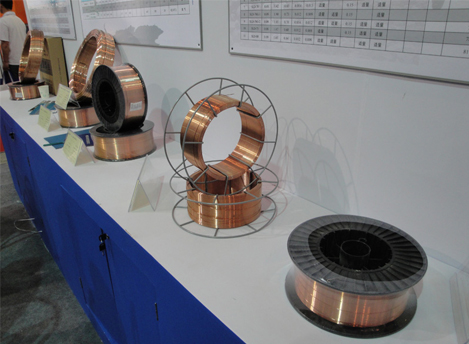The American Welding Society (AWS) offers a variety of classifications based on the mechanical and chemical properties of solid wire. Each letter and number in the nomenclature indicates a specific function. For example, for the commonly used solid wire - AWS ER70S-6 - "ER" indicates that the filler metal is an electrode or rod; "70 " indicates that it has a tensile strength of 70,000 pounds per square inch (psi); "S" indicates that it is a solid wire.6 Reflects the chemical composition and shielding gas requirements.
Solid wire ending in S-3 and S-6 is one of the most commonly used wires in the MIG welding industry. For TIG welding applications, ER70S-2 cut lengths (or electrodes) are commonly used. Solid wire is available in various diameters.
For MIG welding applications, diameters range from 0.023 to 1/16 in. while solid wire used in the submerged arc welding (SAW) process can be 1/8 in. or even larger. TIG cut lengths are available in diameters from 1/16 to 5/32 in. Typical operating parameters for solid wire depend on these diameters and, in the MIG or SAW process, on the wire feed speed. The wire feed speed is proportional to the amperage used for the welding application. The voltage range can be from 14 volts to over 30 volts.

AWS ER70S-6
Common types of solid wire
Each type of solid wire has unique advantages, limitations, and best uses. Below are some common types of solid wire and their properties.
AWS ER70S-6 solid wire
ER70S-6 solid wire is the most common choice for welding mild steel. This widely used wire can be used for general fabrication, automotive welding applications can be used for robotic welding, and to complete root passes for pipe welding and other critical or industrial applications. It provides a smooth and consistent wire feed, which helps increase productivity (less downtime to solve wire feed problems) and the wire helps extend the life of worn parts. When used properly, it produces a smooth weld seam with a uniform overlap.
Welding operators can use ER70S-6 solid wire and 100% CO 2 to increase the depth of fusion of the joint or use an argon/CO 2 mixture to help reduce spatter. They should also be aware that these wires tend to produce silica island deposits on the surface of the finished weld. They will need to remove these deposits prior to painting or other types of surface preparation, which may increase the time required for post-weld cleaning.
Although solid wire usually produces low levels of spatter on clean substrates, it may not be the best choice for welding contaminated metals. However, if there is no alternative, ER70S-6 welding wire may be useful for welding through light rust or oxide skin. This wire contains high levels of silicon and manganese and can act as an excellent deoxidizer.
AWS ER70S-3 solid wire
ER70S-3 solid wire is another common choice and is mainly used in applications where clean welds are important. Like the ER70S-6 product, this wire offers good wire feeding properties, but it also produces clean weld deposits and requires very little post-weld cleaning to prepare for painting or plating. This solid wire is a common choice for automotive and automated welding applications as well as for general fabrication, light sheet metal fabrication, and applications requiring high wire feed speeds.
As with ER70S-6, this wire can be used with 100% CO 2 or argon/CO 2 mixtures, depending on whether greater joint penetration or low spatter is required.
AWS ER80S-D2 solid wire
ER80S-D2 low-alloy solid wire provides higher tensile and yield strengths when welding carbon and low-alloy steels. The D2 designation indicates that the wire is a manganese molybdenum alloy. Manganese is a deoxidizer, making this wire ideal for rusty or dirty metals, and it also helps to improve tensile strength. In addition to high-temperature strength, molybdenum also provides hardenability.
The higher alloy content in ER80S-D2 welding wire can make the arc in spray transfer mode more difficult to control, which can lead to increased spatter. To solve this problem, welding operators may prefer to use the pulsed MIG process.








